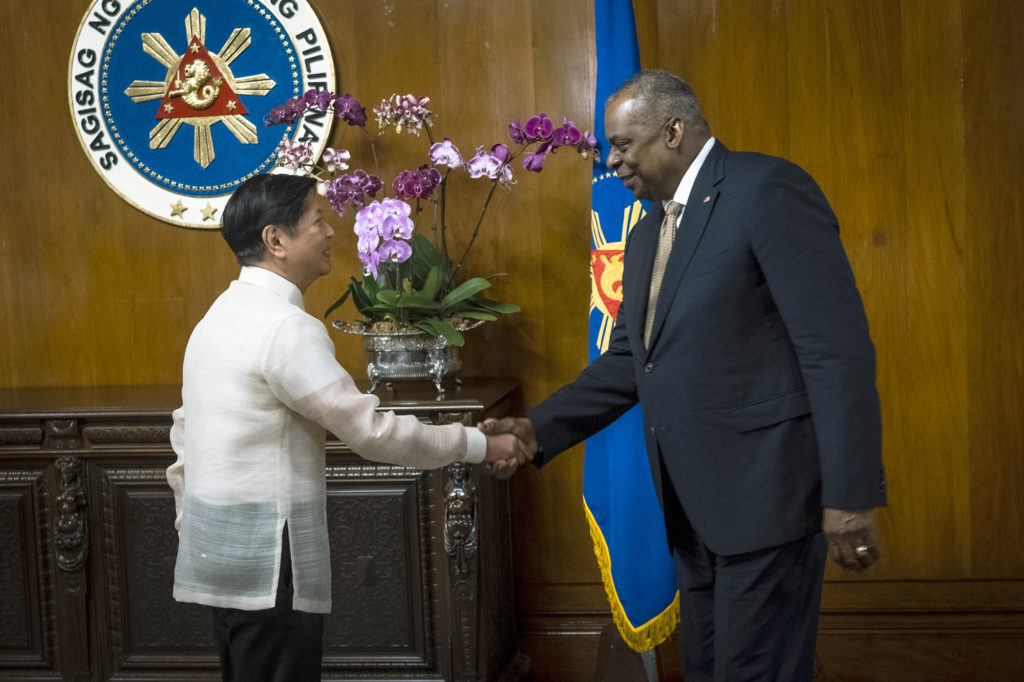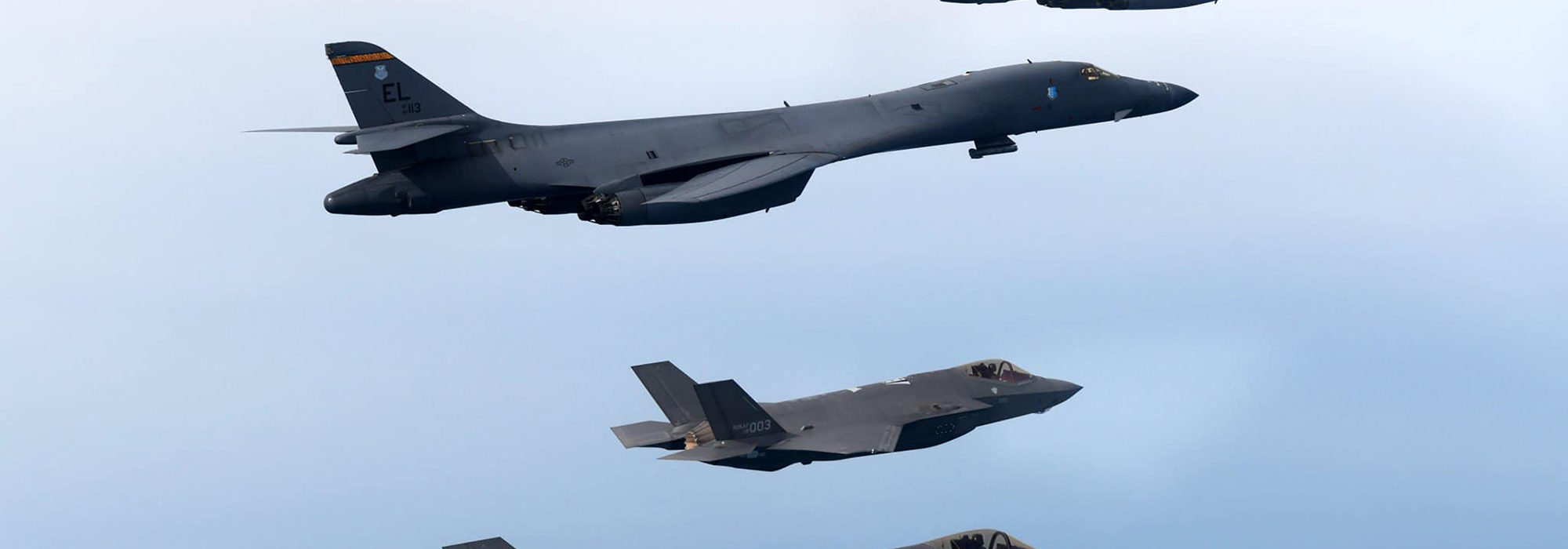B-1s Join F-22s and S. Korean F-35s in Latest BTF Mission
By Greg Hadley
Apair of U.S. Air Force B-1B Lancers and F-22 Raptors flew alongside F-35s from the Republic of Korea (ROK) on Feb. 1—the third bomber flight near the Korean Peninsula in recent months. The jets then trained Feb. 3 with USAF F-22s, Marine Corps F-35Bs, and ROK F-35s.
The B-1s subsequently flew to Andersen Air Force Base, Guam, to kick off another Bomber Task Force (BTF) deployment.
The Republic of Korea Defense Ministry announced the first round of joint air training Feb. 2, saying the aircraft linked up over the Yellow Sea, just west of the peninsula. The ROK Air Force announced the second round Feb. 3, according to multiple media reports, noting that it also took place over the Yellow Sea.
A Pacific Air Forces spokesman confirmed to Air & Space Forces Magazine that the B-1s came from Ellsworth Air Force Base, S.D., and the F-22s came from Joint Base Elmendorf–Richardson, Alaska. A release from PACAF announced the BTF mission.
The combined flight marks the first combined air training between the ROK, or South Korean, Air Force and the U.S. Air Force in 2023, though U.S. bombers have become a frequent sight in the skies near South Korea recently.
In late December, B-52 Stratofortresses from Barksdale Air Force Base, La., flew alongside American F-22s and ROK F-35s and F-15s around Jeju Island south of the peninsula. And in November, B-1s from Ellsworth flew over the peninsula for the first time in five years.
In both cases, the bombers’ flights represented shows of force shortly after North Korea conducted missile tests.
These most recent flights came just a day after Defense Secretary Lloyd J. Austin III visited Seoul and pledged alongside South Korean Defense Minister Lee Jong-sup to increase the size and scope of joint U.S.-ROK military exercises. That includes increased participation from fifth-gen fighters and strategic bombers.
Ellsworth B-1s last participated in an Indo-Pacific BTF in the fall, from October to November.
“It’s a privilege to be back in the Pacific area of responsibility and to be on the forward-edge of deterring our adversaries and supporting our allies,” Maj. Abraham Moreland, assistant director of operations for the 34th Expeditionary Bomb Squadron, said in a statement. “The relationships we have with our allies in the region are crucial to the security of the Indo-Pacific, and the partnerships we build while out here give our aircrews the critical training and experience necessary to be successful in this environment.”
The U.S. missions both reassure South Korea and respond to mounting pressure from North Korea, where Kim Jong Un has stepped up missile tests and recently launched drones over South Korean airspace.
With tensions increasing, South Korean President Yoon Suk-Yeol made waves by saying his country may be forced to either ask the U.S. to redeploy nuclear arms on the peninsula or to develop nuclear weapons of its own. And a recent independent, bipartisan commission recommended the two countries begin “pre-decisional” discussions about what it would take to redeploy tactical nuclear weapons to the region.
US Gains Access to More Bases in the Philippines

By Greg Hadley
The U.S. will be able to rotate troops and build facilities at four military bases in the Philippines, officials from the two countries announced Feb. 1, deepening their military cooperation to counter China.
Defense Secretary Lloyd J. Austin III and Philippine Secretary of National Defense Carlito Galvez made the joint announcement during Austin’s visit to the Philippines.
The deal expands the 2014 Enhanced Defense Cooperation Agreement (EDCA), which did not allow U.S. troops to be based in the Philippines but did authorize access to “agreed locations … on a rotational basis, for security cooperation exercises, joint and combined military training activities, and humanitarian assistance and disaster relief activities,” according to the State Department.
The two countries had previously agreed to five locations, including four air bases. The U.S. has already allocated $82 million in infrastructure for those bases, the Pentagon noted in a release.
Officials declined to name the locations of the four new bases, with Galvez saying in a joint press conference that they will do so after consultations with local authorities. Possibilities include Clark Air Base, where the U.S. Air Force operated until 1991. In 2012, the Philippines agreed to give U.S. forces limited access to the base.
The U.S. and the Philippines have a long military relationship, dating back to the Spanish-American War, after which the U.S. acquired the territory from Spain. Even after its independence following World War II, tens of thousands of Filipinos joined and served in the American military, and the U.S. maintained a robust presence in the Philippines for decades. In 1991, the Philippine Senate voted not to reauthorize the basing agreement, and the U.S. left its bases there the following year.
Even after that, the two countries maintained close ties and conducted frequent military exercises together. During President Rodrigo Duterte’s time in office, he threatened to scale back joint exercises with the U.S. and pursued closer ties with Russia and China. That delayed implementation of the EDCA.
After Duterte left office in 2022, he was succeeded by Ferdinand Marcos Jr., the son of controversial former President Ferdinand Marcos Sr., who ruled for more than 20 years, imposing martial law for part of that time.
Under the younger Marcos, relations between the U.S. and the Philippines have strengthened, and EDCA projects are again ramping up. Said Austin: “This relationship is strong, and we will continue to work hard to strengthen it further.”
In January, U.S.. Pacific Air Forces Airmen visited Clark Air Base and Basa Air Base in the Philippines for a subject-matter expert exchange with the Philippine Air Force. They discussed “munitions, maintenance, logistics, and hot-pit refueling … [in] a precursor to cooperation in future large exercises in the Indo-Pacific region,” according to a Feb. 2 news release.
Galvez expressed interest in expanding the Philippine Air Force’s capabilities with U.S. platforms and further engagements in the future.
“We really need C-130s, and also those Black Hawks that we bought that we configured to search-and-rescue capability,” Galvez said. The Philippines signed a deal for 32 Black Hawk helicopters in February 2022 and has made moves to acquire C-130Js as well.
